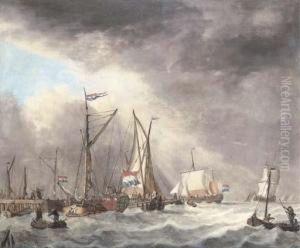Jan Verbruggen Paintings
Jan Verbruggen was a notable Dutch artist and master cannon founder who lived during the 18th century. Born in 1725 in The Netherlands, Verbruggen is particularly recognized for his advancements in artillery technology and his role as a leader in one of the most famous foundries of the era.
Although not an 'artist' in the conventional sense of painters or sculptors, Verbruggen's artistry was expressed through his technical skill and innovative approaches to the casting and construction of cannons. Jan Verbruggen's professional life was largely tied to the Woolwich Arsenal in England, where he served as the Master Founder. He was appointed to this position in 1770, after his reputation for excellence in cannon making reached the British authorities.
Verbruggen's contributions to the field include the introduction of new techniques for boring cannon barrels that significantly improved their accuracy and efficiency. This was a crucial development during a period when artillery was becoming increasingly important in warfare. Under his leadership, the Woolwich foundry became one of the most modern and productive of its time.
Jan Verbruggen was also known for his collaborations with his son, Pieter Verbruggen, who followed in his father's footsteps. Together, they implemented numerous improvements in the foundry's operations, which allowed the British to expand their artillery capabilities during the years leading up to and including the American Revolutionary War.
Verbruggen's death in 1781 marked the end of an era for the Woolwich Arsenal, but his legacy lived on through the cannons he helped produce, many of which were used in battles across the world. Despite being less known than traditional artists, his work had a significant impact on the history of warfare and artillery manufacturing.
